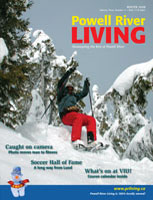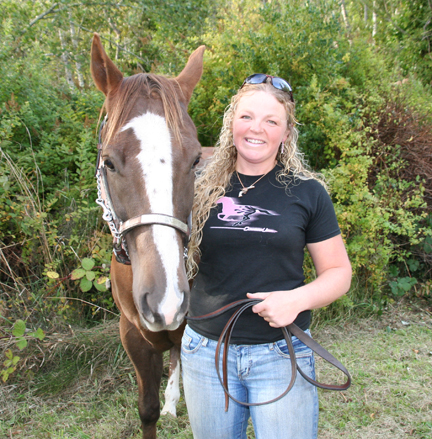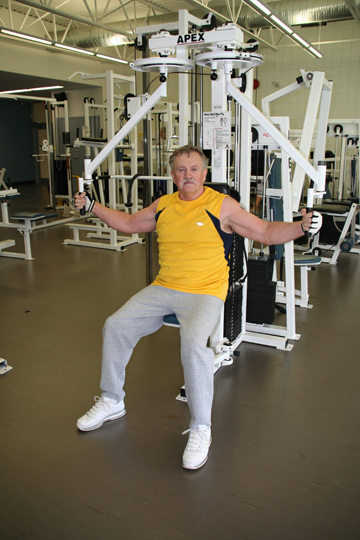>> This entire issue is available as a 13MB PDF download
Table of Contents
Catch the Olympic spirit
A home for Radar
Making the bed
Thinking of others
Making a living from home
How Fading Fast lost weight and helped!
Banff Mountain Film Festival
Making a difference in the lives of others
Soccer player inducted into sports hall of fame
Live Professional Ballet coming
Home share lets you pick your family
Picture motivates man to better health
Kudos
Great Depression gave us Chamber of Commerce
Foundation for life
Nothing But Sky
A green Christmas
Point of VIU:
A celebration and a gift
Family Place celebrates families
Book benefits Therapeutic Riding
Spiral, by K.L. Denman
Bonus web content:
Listen to some of Devon Hanley's music
Listen to sound samples from Romeo & Juliet by Ballet Jörgen Canada
Catch the Olympic spirit
Torch coming to Powell River in 2010
By Isabelle Southcott
It was with great anticipation and curiosity that a crowd gathered on the front lawn of City Hall on a wet and blustery November day to hear a special announcement by Mayor Stewart Alsgard.
“I am thrilled that Powell River has been chosen as one of the celebration communities for the 2010 torch relay. This significant event comes to us recognizing the many positive facets of our community such as our close relationship with First Nations and as a Cultural Capital of Canada. Most importantly, this honour recognizes the hundreds of people in our community who reflect the Olympic Spirit by volunteering and dedicating their time and energy in our sports, cultural and youth activities.”
The Olympic torch will be in Powell River on February 3, 2010, Day 97, of its journey. From Powell River it will travel down to the lower Sunshine Coast. The Vancouver 2010 Olympic Torch Relay route will be the longest domestic torch relay in Olympic history, stretching over 45,000 kilometres throughout Canada. Upon its conclusion, it will have been welcomed in over 1,000 communities and passed within one hour of more than 90 per cent of the entire Canadian population.
The 2010 Olympic torch relay is over 100 days long. It will begin on October 30, 2009 and complete the cross-country journey at Vancouver’s BC Place on February 12, 2010 as it lights the Olympic Cauldron, signalling the start of the Vancouver 2010 Olympic Winter Games.
There will be several opportunities to apply for torchbearer spots and the torch relay’s presenting partners, Coca-Cola and RBC, invite interested individuals to apply at iCoke.ca or rbc.com/carrythetorch.
The 2010 Olympic Winter Games will be staged in Vancouver and Whistler from February 12 to 28, 2010 and the Paralympic Winter Games will take place from March 12 to 21. Visit vancouver2010.com for further details.
A home for Radar
From rags to riches
By Isabelle Southcott
This is a sad story. It is the story of a horse and a young woman. It is the story of hunger, disease and neglect.
It is the story of love, commitment and hope.
Four years ago Sondra Butler and her friend Teresa Halliday heard about some horses that had been rescued from a horse farm on Vancouver Island. They were horse lovers and wanted to see these rescued horses.
“I couldn’t believe it,” said Sondra. “They were so sad. There was a blacksmith there from 100 Mile House and he said they should be put down, don’t even bother with them.”
The horses had been kept in deplorable conditions. They weren’t fed enough; they weren’t groomed or wormed; their feet weren’t looked after. When hay was thrown in the corral, the bigger horses would eat it but the smaller ones wouldn’t get enough. The horses would sink in the mud which they had to stand in all day and so they ended up with hoof rot. They were covered in lice, caked in mud, and extremely thin.
But horse people can be stubborn. There’s common sense and then there is emotion. Sondra’s heart went out to a six-month old quarter horse that was half starved, covered in lice and full of worms.
She went home and thought about this little horse. She talked it over with her boyfriend and family because a horse is a big commitment and she already owned three horses. Sondra didn’t need another horse but this horse needed her, so Sondra decided to take him. Her friend Teresa decided to adopt the other horse.
“They did not have any energy. They could hardly get in the trailer. They were so malnourished and all covered in lice.”
The horses had to be quarantined because lice can spread.
“We had to scrub them down, mud was so caked on them and they were covered in mats. We had to cut mats off their stomachs. We couldn’t even worm them until we got food into their system.”
Sondra says the horses were in such a sorry state that their hooves were literally rotted from standing in wet mud.
Sondra’s mother Margareta remembers seeing the horses for the first time. “You could count the ribs. Mud was caked up and down each leg. Lice crawled all over his body and his hair was completely matted. Then the work started: visits to the vet, hours and hours spent shaving the horse, bathing it with special shampoos to clear the sores and getting rid of the lice. Special formula had to be fed to the horse and a thorough cleaning of the hooves.”
Bit by bit, day by day, the horses improved. Sondra’s horse, Radar, a registered quarter horse, developed a special personality and soon the two were inseparable.
“I love him to death,” says Sondra. “I was going to sell him but I can’t.”
Radar put on weight, his coat developed a shine and he flourished.
Her vet, Dr Hall, and blacksmith Mike Schulkowsky helped with Radar’s recovery and today, he is strong and healthy.
“His coat is just gleaming now,” Sondra says proudly. “He’s almost 15 hands.”
Radar has gone from rags to riches. At the Fall Fair in September, Radar, (Doc’s Boston Bear) won several first place ribbons and the pair won the high point senior rider award.
Sondra’s mother was on hand to see this performance. “Radar was so grateful for all the love and care Sondra had given him, he wanted to show his appreciation by giving the best performance he could. That horse put his whole heart into it and I was in awe to see the happiness that radiated from that horse. He made Sondra proud of him and earned her the highest points in their category.”
Many people have been touched by this story, says Margareta. “ I had to write to you about this special horse. It is such a feel good story, we need more stories like this today.”
Making the bed
More than tucking in sheets and fluffing up pillows!
By George Campbell
Who makes the bed in your house? (I am assuming, of course, that you live in one of the 86% of Canadian homes where the bed gets made every morning.) In our house we started out by agreeing that whoever gets up last has to make the bed. This ended up being me, every time. But it turned out that my wife didn’t like the way I tucked in the sheets, so she took over. I am quite pleased about this because I didn’t much like the way I made the bed either.
Making the bed is a nuisance chore. When you’ve just crawled out from under the covers in the morning, late for work, making the bed certainly seems to be last on the list of priorities. But, when you’re ready to go to sleep after a long, stressful and wearing day, oh, how sweet it is to turn back the warm blankets on a nicely made bed and snuggle under the clean, crisp sheets for some well-earned shuteye. With this in mind, (and also because I didn’t really have much else to do) I Googled ‘bed making’ on my computer.
I was astounded to come up with fifteen million, four hundred thousand websites to do with this annoying little household chore. Apparently making the bed, who does it, and how to do it, looms large and important in the minds of many citizens. And understandably so, because we pretty much all sleep in a bed, and as already noted, prefer one that has been nicely made up.
The first few websites I looked at dealt with how to make a bed. This was explained in steps as follows: Step 1 – First and most important, get up and out of the bed. Step 2 – Check to make sure no one else is in the bed before proceeding to step 3. There then followed steps 3 through 5, which dealt with how to tuck the sheets, spread the blankets, and fluff up the pillows. These directions concluded with the statement that the chore should be completed in less than ten minutes. Yesterday morning I decided to try it. After 15 minutes my wife hollered from the other room, “Aren’t you done yet?” I replied sheepishly, “I’m still dealing with step number one.”
Not all of the websites I examined described how to make the bed. One was entitled, “Bed Bugs Making a Comeback.” Bed bugs are small, brown, blood-sucking insects about one quarter of an inch long that like to hide in the crevices and seams of mattresses. They were prevalent all over the world prior to WW II, then the rise of DDT and other pesticides nearly wiped them out. According to this website, bed bugs are now making a comeback in cities like Boston, New York and Chicago.
I read about this one guy who was checking into a hotel in Chicago when a bed bug ran across the register. The guy promptly cancelled his room reservation telling the desk clerk, “It’s bad enough that you have bed bugs in your hotel, but when they come downstairs and check the register to see which room you’re in, that’s just too much!
Another website told the story of a guy who was married to a neat freak. This woman couldn’t wait to make the bed, scrub and wax the floors, do the dishes, etc. One would think it would be great to be married to such a gal as the house would be a sparkling show place. But such a marriage has a down side. The husband explained that he and his wife slept in twin beds. He went on to tell about how he woke up one night to go to the bathroom and when he got back the bed was made.
Whoever makes the bed at your house should Google ‘making the bed’ on their computer. Not only will they find out a lot of interesting things about bed making, they’ll discover that reading about it is a lot more entertaining than actually doing it. I know I did.
Thinking of others
How you can help those who need it
By Isabelle Southcott
Powell River residents love to experience the joy of giving, especially at Christmas and there are many ways you can help others at this time of year.
Christmas Cheer has been providing hampers for those in need for close to 60 years. They rely on cash donations to purchase food and donations of toys and gifts to help those in need. Donations are down this year and the price of groceries is up so groups like Christmas Cheer and The Powell River Food Bank, (which provides food year round) are having a harder time rounding up donations. Many schools, businesses and church groups donate to the food bank during the month of December to help folks get through the long winter months.
At this time of year, The Salvation Army is often on our minds as we see volunteers in the community with their kettle program. The CAT Scan campaign has been gathering steam this year and this cause is on everyone’s mind.
When it comes to making a financial donation to a charity close to your heart, who would think that spending more money during Christmas could actually save you money next year?
If you would like to increase your tax savings in 2009, the easiest way is to make a charitable donation before the end of 2008. To do so, gifts (cheques) must be postmarked no later than December 31 to be eligible.
Charitable donations qualify for a tax credit rather than a tax deduction and reduce your income that is subject to tax. Be sure to get a receipt for your charitable donations and remember, every bit counts!
Statistics show that 91 per cent of Canadians give to charities on a regular basis.
The spirit of giving was evident at last month’s Horizon Business Awards. Jack and Jim Barr of the Powell River Town Centre Ltd. started the ball rolling by donating a $20,000 cheque to the CAT Scan and others soon followed suit with total money raised for the fund that night coming in at $31,000.
The CAT Scan’s next big fundraiser is the New Year’s Eve Gala, which will be held at Dwight Hall. There will also be a silent auction and the draw for a brand-new 2008 GM Uplander donated by Felix Massullo, owner of Massullo Motors at the Gala.
Right now the fund stands at $1, 161. 378.
Tickets for the car raffle are available at several Powell River businesses including the Town Centre Mall, Anderson’s Men’s Wear, First Credit Union, Massullo Motors, River City Coffee, and from members of the Rotary Club and Hospital Foundation.
“It’s a big challenge,” says CAT Scan treasurer Ken Needham noting that fund now stands at a little over one-third of the cost of the projected $3 million cost.
Making a living from home
By Regina Sadilkova
With the possibilities of technology, the variety of home business undertakings and income sources in our community is increasingly broad. This article is about one such business—a unique service provided locally by Robert Colasanto.
After an early visit to the BC coast, Robert and his wife Jessica made a decision to find a way to move and make a living somewhere on the west coast by no later than the next millennium.
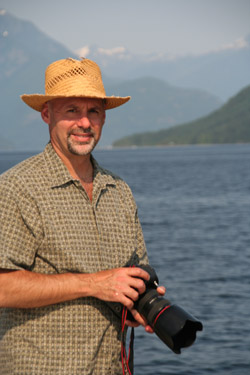 By trade Robert is a photographer. He is developing a local niche business photographing artists’ work for reproduction sales. His commissions are for both flat work (paintings or drawings) and three dimensional craftwork including ceramics and jewellery. Robert also undertakes image restoration work such as his recent contract with the Powell River Museum and Archives for the retrospective of Rod Lemay’s work chronicling the early days of Powell River. Most of Robert’s current commissions are for local Powell River artists as he works to expand client base to the lower sunshine coast and Vancouver Island. He will undertake contracts whereby an artist does not have to purchase a high number of prints but still focuses on the high quality of the reproduction. He can compete with similar services in the lower mainland for significantly lower fees given his lower overhead and small scale operation while having high end equipment, time, experience and attention to colour integrity and detail.
By trade Robert is a photographer. He is developing a local niche business photographing artists’ work for reproduction sales. His commissions are for both flat work (paintings or drawings) and three dimensional craftwork including ceramics and jewellery. Robert also undertakes image restoration work such as his recent contract with the Powell River Museum and Archives for the retrospective of Rod Lemay’s work chronicling the early days of Powell River. Most of Robert’s current commissions are for local Powell River artists as he works to expand client base to the lower sunshine coast and Vancouver Island. He will undertake contracts whereby an artist does not have to purchase a high number of prints but still focuses on the high quality of the reproduction. He can compete with similar services in the lower mainland for significantly lower fees given his lower overhead and small scale operation while having high end equipment, time, experience and attention to colour integrity and detail.
Robert stumbled upon this niche business after experimenting with copying one of his father’s paintings. He was happy with the results and continued augmenting his skills and equipment to get where he is today.
Robert originally studied advertising art in New York in the late 1970s and earned a living on the side as an auto repo man (that would be another story) but also doing portrait, fashion portfolio, and wedding photography work. These make for a soup of stress: photographing people can be challenging when clients have self image issues. So Robert began to focus his freelance work on travel and animal photography, particularly in the animal welfare realm. Harp seals proved to be easier to please than potential super models. In the 1980s he moved upstate for pre-engineering studies and business at Syracuse University where he met his wife Jessica and became a self-proclaimed ‘lab rat.’ In the lab they were afforded the time and equipment to get a thorough understanding of computers right about at the heady dawning days of the internet. Once Robert was high tech adept it was time for a big change. So they packed up and worked on a dairy farm in rural upstate New York for most of the 1990s. With one eye on the calendar and approaching millennium, they thought computers and the internet may be the ticket to the west coast.
So in 1999, they packed up again and made the journey west to see family in the lower Sunshine Coast and then continued north. They both had previous expertise in paper science and thought the mill may be an option. Since nothing came of that, they began growing and expanding their capacity in digital and data services and here they are. Jessica is a home based writer, instructor, web designer and mother of three young home-schooled children. All this in a 1000 square foot bungalow, it’s a full house from foundation to rafters and carport.
Robert has a highly recommended website with all his contact information, samples of work, and a rundown of his services. See www.robertcolasanto.com for more information.
How Fading Fast lost weight and helped!
Bruce Denniston Bone Marrow Society fundraiser
January is a month for new beginnings, life changes and a time to get healthy.
In 2008, three friends from the Paddling for Life Dragon Boat team decided to do just that by joining Avid Fitness and their partnership with Bruce Denniston Bone Marrow Society (www.dennistonsociety.org) in their Donate the Weight campaign. They added a young, enthusiastic fourth member and optimistically named themselves “Fading Fast.”
Ninety-four participants and 19 teams signed up for the challenge at Avid Fitness, whose fitness gurus kept everyone motivated and on track.

Everyone was weighed and measured three times over the course of three months and everyone got to choose their own schedules. “Diana chose to go to the gym five times a week while Lorna and I went three times a week. Katie worked on her own, which is perfectly acceptable—gym membership is not required,” said Pat Greenwell, team member of Fading Fast.
“Donate the Weight” may be a catchy title, but it actually means a much healthier “Donate the Inches.” Losing inches is much harder work, and requires strength training, diligence, and perseverance. The team aspect helps a great deal, as does gym attendance, a regular routine, and encouragement by friends and family, said Greenwell.
At the end of March “Fading Fast” had done it. They won in two categories, (most combined inches lost and most combined pledges).
“The four of us lost a combined total of 117 mm and raised $745 in pledges,” said Greenwell.
As a bonus, Robbie Holmgren and Greenwell tied to win first place in the individual category of most inches lost, with a loss of 66 mm.
The Donate the Weight campaign raised over $4,000 in 2008 and is an ideal campaign for the Bruce Denniston Bone Marrow Society. With a mandate to educate the public about the need for bone marrow donors, the requirement for funding is ongoing.
Registration for this year’s Donate the Weight campaign begins January 2 at Avid Fitness. Visit www.dennistonsociety.org or call 604 485-8488 for more information.
Banff Mountain Film Festival
January event features great outdoor films and photos
If January is looking like a bit of a hum-drum month, mark Friday and Saturday, January 9 and 10 on your calendars and plan on attending the Banff Mountain Film Festival at Brooks Secondary School.
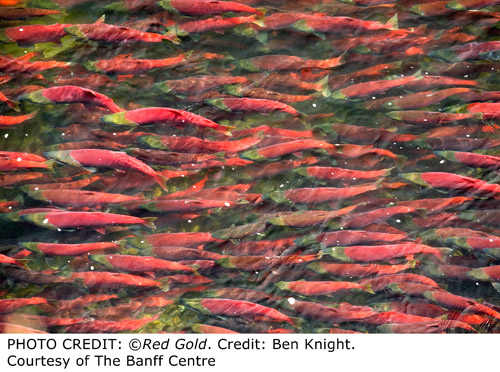
Banff Mountain Film Festival organizer Jim Palm is excited about this year’s schedule. “I’m bringing in the best of the Banff Photo Contest. There will be 18 winning prints on display around the Great Hall,” he says.
The film festival has a social gathering focus, says Palm. And once costs are covered, half the proceeds from ticket sales will be donated to the CAT Scan Fund with the other half going to the students at Brooks.
Doors open at 6 pm in advance of the film event. Appetizers and finger food prepared by the Culinary Arts program will be served; wine, beer and non-alcoholic drinks will be available at reasonable prices. “It’s a nice evening to bring people together for a bite and to chat,” is how Jim Palm describes the evening.
The doors to the Max Cameron Theatre open for the film festival at 7 pm.

Always open to experiential opportunities, this year the event is being student-led. “This is a new initiative. I’m working with Kathy Rothwell (principal at Brooks) and she will supply me with students to organize the show and to introduce the host from the Banff Mountain Film Festival.”
Tickets are available at Taws Sport & Cycle, River City Coffee, Thunder Bay Store and Brooks Secondary School.
For more information, to reserve tickets, or if you are interested in participating as a sponsor please call Jim Palm at 604 483‑3171 or jpalm@sd47.bc.ca.
Making a difference in the lives of others
Salvation Army helps out all year long
Others.
If you could sum up what the Salvation Army does in just one word that word would be others.
“Helping others is what we are all about,” says Salvation Army Captain Rick Robins. “It feels good when you see a smile on someone’s face. We help as much as we can with what we have however we can.”
Rick and his wife Jennifer lead Powell River’s Salvation Army. Through the army’s various ministries, they expect to help more than 8,000 people by year-end. Their Christmas kettles are out colleting funds with this year’s goal set at $60,000.
It looks like more people will need help this year. “I think this Christmas we will see a lot more people,” said Jennifer, pointing to the downturn in the economy and local layoffs.
“We’ve had new people come in that we have never seen before. People’s lifestyles have changed because of job losses. There is more and more need but fewer resources.”
Rick remembers clearly how the Salvation Army helped his family out. He’d been working in the oil patch and oil dropped to $9 a barrel. Rick was injured and they had no money saved and Christmas was just around the corner. They knew they needed help but somehow, couldn’t bring themselves to ask and then, someone gave them a hamper.
“It’s not just the food that helps you, it’s knowing that someone cares, that you are not out there by yourself,” says Jennifer.
The Salvation Army has been helping those in need for more than 100 years but they would not be able to do what they do without their volunteers. “The volunteers are the army behind the army,” says Rick. “The only reason we can do as much as we do is because of our volunteers.”
Money donated to The Salvation Army’s Christmas kettle campaign supports the community and service work of the army.
“People are worried how the Salvation Army can help,” says Jennifer. “But that is when it has done the most, during tough times. We are good at being resourceful. We are not going anywhere, we will always be here and we will always find ways to help.”
Because the kettle campaigns are organized locally, funds raised in Powell River remain in Powell River and are used for Salvation Army purposes here.
The Salvation Army welcomes everyone with open arms.
“Our work encompasses the entire community, not just the poor,” says Jennifer.
The Army is putting on a community Christmas dinner on December 21 at the Moose Hall. It is free of charge but tickets must be obtained from the Salvation Army. For more information or if you would like to help with the Christmas dinner or the kettle campaign, please call 604 485-6067.
Soccer player inducted into sports hall of fame
Brett Pence and Winnipeg Fury recognized for historic performance
By Carma Sacree
Many a Saturday morning my mom would make the trek from Lund to town with two eager soccer players in tow. Both my brothers, Matt and Brett Pence, loved and excelled at the sport and ended up playing for Powell River Villa.
At 22, Brett headed off to Australia for a year to play in a semi professional league on the Gold Coast. Upon his return Drew Ferguson, who coached and played for the Canadian Soccer League team, The Kitchener Kickers, decided to give Brett a chance in the Big League. At the end of his first year with the Kickers, Brett, who played forward and midfield, was traded to the Winnipeg Fury Team. It wasn’t long into that year before he won Player of the Week and tied the Canadian Soccer League record for the most goals scored in a single game, which still stands today at four goals.
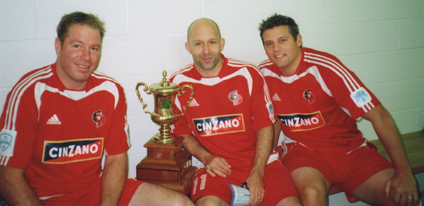
Coming into the league’s final two-game series in 1992 as heavy underdogs, the Canadian Soccer League Winnipeg Fury team unseated the four-time champion Vancouver 86ers, who were loaded with National team players, to win the Canadian Soccer League Championship and the Mita Cup. The Fury had never won a game in Vancouver at the Swangard Stadium. In fact, they had taken huge hits against the 86ers that season with scores like 5-0 and 6-0, so you can imagine the celebration when they won.
It was because of this historic performance coupled with the fact that the entire league folded after that season, making the Winnipeg Fury’s the last team to win the Mita Cup, that the whole team was inducted into the Manitoba Sports Hall of Fame in Winnipeg on November 8, 2008. Fifteen of the 18 team members made the trip, one traveling from as far away as Croatia. The former team played an exhibition game Saturday morning and attended a formal dinner with 800 people in the evening where they were officially inducted and received a Hall of Fame ring. Brett said, “It was good to catch up with all the guys and talk about the good old days.”
Brett carried on playing professional soccer for an additional year in a different league after the Winnipeg Fury folded and has enjoyed playing for Villa for almost 20 years. He can’t wait to make the trek himself to the soccer fields with his two adorable sons Colt and Kye when they are old enough to play. Powell River and his boys will be lucky to have him as a coach.

Live Professional Ballet coming
Ballet Jörgen Canada to perform Romeo & Juliet
By John Silver
Max Cameron Theatre (“the Max”) at Brooks School is now in its second season of live opera broadcasts by satellite transmission from New York’s Metropolitan Opera House. Last December the Max also ventured into ballet in the same format, presenting the National Ballet of Canada’s Nutcracker. Jacquie Dawson, the Max’s manager, is now going one better on the ballet front. This coming February she will bring to Powell River a live performance of Romeo & Juliet by Ballet Jörgen Canada. Founded in 1987 by Bengt Jörgen and Susan Bodie to create an opportunity for Canadian choreographers and original new works in classical ballet, Ballet Jörgen Canada has developed a reputation for work that combines innovation, warmth, humour and beauty. |
Listen to mp3 sound samples here: |
It is the second largest dance company in Ontario and the only major Canadian ballet company with a repertoire consisting exclusively of original works. The Company tours across Canada and North America performing to almost 50,000 people in over 40 different communities, touring coast-to-coast and into the United States.
The company’s artistic director and CEO, Bengt Jörgen, is a dancer/choreographer who has created over 30 ballets that have premiered nationally and internationally. In addition to Romeo & Juliet, the company’s current repertoire includes full-length productions of Cinderella and Coppélia, and an original dance program comprising Rendezvous by Robert Desrosiers, Petrushka by Bengt Jörgen, and other shorter works.
Ballet Jörgen Canada has two ballets for children in its repertoire, The Velveteen Rabbit and The Emperor’s New Clothes. Recent new works include Anastasia, which premiered in 2007 with Symphony Nova Scotia, and the Group of Seven Nutcracker which made its debut at the 2008 Charlottetown Festival.
The company runs the only college-level dance program in Canada, George Brown Dance, with 64 full-time students enrolled in the program.
Ballet Jörgen Canada will perform Romeo & Juliet with 16 dancers in 12 Western Canada locations from the beginning to end of February 2009. Powell River will be the third of five BC stops before the company moves to Alberta for five shows and then Saskatchewan for two.
The Romeo & Juliet ballet, to a stunning score by Sergei Prokofiev, presents Shakespeare’s tale of love, anguish and revenge in the Montague and Capulet families that ultimately leads to the deaths of the two central characters. While remaining true to the original story, Jörgen, in his role as choreographer, focuses on principal scenes and development of the lead characters. Glenn Davidson has created the costumes and beautifully minimalist sets with Gary Dahms responsible for the lighting design.
Already performed in major cities and communities across Canada, the United States and China, Ballet Jörgen Canada’s intimate interpretation of this timeless classic has won international recognition and critical acclaim. Romeo & Juliet will be performed live at Max Cameron Theatre on Thursday, February 5, 2009 at 7:30 pm. Advance tickets are on sale now at the Academy of Music Box Office (604 485-9633) and, if not already sold out, may also be purchased at the door on the day of the performance.
Home share lets you pick your family
Program brings together
By Roger Whittaker
Casey the family dog, chief of household security detail, joins Ted and Gwen Welp in his generous inclusion of Dan to his list of family members. Loud barks greet all others and continue until regular members of the household quiet Casey’s vigilant surveillance of his domain. Dan Legault takes his place at the dining room table between Ted and Gwen; he is not just included in the family dynamic but actually a part of it. Inclusion such as this is the goal of PRACL’s (Powell River Association for Community Living) Home Share Program.
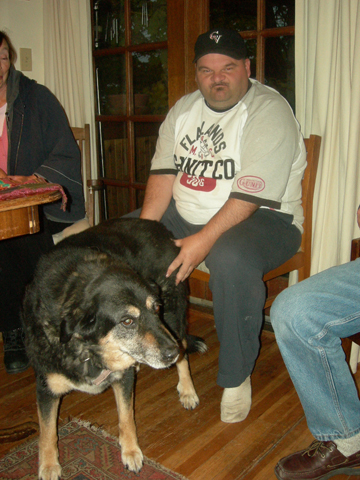
Ted and Gwen have a home used to the lively traffic and activity of a growing family. Now, with their children achieving successful adulthood, the house rattled empty and loomed large. They tried some home stay students who were in town to take advantage of English language training, but those stays, as enjoyable as the students were, were satisfactory only on a short term basis, and the Welps desired to have a relationship with someone who could become more like a member of their family. A friend who knew PRACL was in search of families to be part of the Home Share Program recommended that they investigate the opportunity.
First and foremost on the mind of a family manager might be whether or not an additional mouth to feed and body to wash and laundry to do would be a drag on the household finances. According to Ted, it’s a good balance because, “financial provisions provided by the Home Share Program are fair and equitable.”
Additional income is only one of the benefits felt by the Welps. Dan picks up his end of the chores and makes himself a productive member of the household. Chopping and carrying firewood, tending the stove, cleaning up his own dishes after supper and doing his own laundry keep Dan occupied when he is off from any one of his three jobs: Rent a Flower, Top of the Hill Store and the shredder service operated by PRACL. Dan looks after his own transportation needs by relying on city transit services and his bicycle. Having a computer in his room allows him to spend free time surfing the web or chatting with many of his various friends on Facebook or Messenger. Dan uses his own money to rent movies or go for coffee, and occasionally has his parents come over and share a meal at his home with the Welps.
Dan provides a clear picture of why group homes were not the right approach for him. The people running the group home are often focused on those who have greater needs and “there were always too many people around,” people lacking social skills, demanding attention be paid to them. This noisy environment upset Dan’s usual serene approach to life. He tried to live on his own and soon found day-to-day management isolating. At a turning point in his life, Dan rearranged everything and took out a personal skills contract with PRACL to cement an agreement between himself, PRACL and his new Home Share Family, regarding expectations of behaviour and care. When a problem arises, everyone turns to the framework of the contract and a solution is arrived at. Dan points out, “The independence and the quiet are wonderful.” Isolation that developed while on his own is nipped in the bud by interaction with Ted and Gwen. Dan enjoys the benefits created by being in a relationship with people who relate to him as a person, and Ted and Gwen enjoy requited gratitude offered by a person of such genuine, un-jaded qualities as Dan demonstrates.
PRACL includes Home Sharing as part of their Residential Services Program and will work with others to create good lives in welcoming families. If sharing your home is something you think might work for your family, you are ready to call PRACL at 604 485-6411 ext 232 and chat with Program Coordinator, Debbie Sarnowski.
Picture motivates man to better health
Revealing photo changed his life
Is a picture worth a thousand words?
According to Larry Thompson, the answer is clearly “yes”. One year ago Thompson was sitting in front of his computer wrapped in a bath towel. He’d just gotten out of the shower when his wife took a picture of him. That picture changed his life.

“I call it my motivational picture,” says 63-year-old Thompson who keeps a copy of it on his key chain as a reminder of what he looked like in December 2007.
The “all telling” picture shows a 204-pound Thompson with a huge gut. “It was an ego destroyer,” he admits. “I had no idea I had let myself go that far.”
Just as soon as Christmas was over Thompson headed to the gym at the Powell River Recreation Complex. At the time, the weightlifting belt he used to wear 30 years earlier wouldn’t come within eight inches of fastening up. “Between the picture and the belt, I was truly motivated.”
Thompson lost more than 30 pounds in the last year. He can wear his weight belt again and he is enjoying better health. But Thompson has also changed his eating habits. Instead of eating dessert after dinner, he reaches for fruit. And when his wife was doing her Christmas baking, he exercised extreme will power to stay away from her fabulous mincemeat tarts!
Although Thompson put together his own workout schedule, trainers at the gym have been very helpful. “Roché (Rossouw) has helped with suggesting things like “Larry, why don’t you lower your weights and do it this way?”
Rossouw says Thompson’s story is truly inspiring. “I saw him change right before my eyes. I saw someone who is extremely motivated and it started with that picture!”
Thompson, who works out four times a week at the complex, has never felt better. And if he ever needs a good dose of motivation, all he has to do is look at the photograph his wife took of him last year and he’s off the couch and in the gym!
As for Rossouw, she says that if more people had candid shots taken of them over Christmas the gyms would fill up in January!
Powell River residents continue to amaze us with their many accomplishments. Here are but a few recent ones we have heard about. If you have an item to contribute for this column, please let us know about it by email to isabelle@prliving.ca.
- Powell River dollmaker Camille Allen won the prestigious triple crown of doll awards, winning Doll of the Year award from Doll Reader magazine and their people’s choice award, as well as the DOLL Magazine Award of Excellence for her miniature doll named Cherished. Allen’s dolls are also featured in the latest book from Ripley’s Believe It or Not!
- First Powell River Rangers Amanda McCann and Emily Anderson recently achieved their Canada Cord. The girls were presented with the prestigious award on November 22. The Canada Cord is the highest award a Pathfinder can earn and it allows the recipient to meet new people, learn great new things, put their leadership skills into action and, best of all, make a difference in their community.
- Congratulations to Powell River’s new city councillors, school trustees and area directors!
- Congratulations to all the winners and the runners up at this year’s Horizon Business Awards.
- Congratulations to the Powell River Kings at the top of their league standings! Go Kings Go! It’s your time to shine.

Great Depression gave us Chamber of Commerce
By Gerry Gray
In 1928, the New York Stock Exchange collapsed, resulting in a decade of global depression. Powell River was no exception in feeling the pinch and merchants feared customer credit was extending past their ability to pay, thereby weakening the town’s economic base.
Just before Christmas of 1931 a group of 60 community businessmen got together to form the Powell River District Credit Association, ostensibly to help their debtors get a payment plan in place to pay off their bills in an orderly manner. The initial group was limited to dealers of foodstuffs and dairymen.
The credit crisis was brought under control and within three months the PRDCA changed its’ name to the Powell River Board of Trade, and expanded its membership to include all businessmen and professionals. Bob James was the first Board president. His executive comprised Martin Alsgard, Harry Reed and C. Zorzi. Three generations of the Alsgard family, Martin, Al (president-1959) and Stewart (president-1987), served on the executive. RC Knox was elected president at the first annual general meeting in February 1934. The first woman on the Board was Miss Mim Melville. Margaret Ferguson was the second woman and first to serve as president, but that wasn’t until 1981. Her term opened the door for businesswomen to join the ranks of their male counterparts and many did.
The initial project of the group was to secure better radio transmission for the area. The only link to the outside world was radio and because of weather, interference static wiped out radio programs from Vancouver. Powell River was really isolated in those days. This problem was solved by installing antennae on Texada Island which relayed radio signals to Powell River.
The new group was off and running with 80 members (98% attended most meetings) and all were active in various committee projects. These projects included initiating road surfacing between the four municipal communities; government telephone and telegraph service; acquiring a school nurse; a boat anchorage and breakwater in Westview; government inspection of dairy herds in the district; a new provincial building; a change of passenger ship docking from the mill to Westview and an airport committee which resulted in airport operations by 1952. Perhaps one of the greatest projects the Board of Trade instigated was completion of a paved road to Vancouver in 1954. With this road link, Powell River could truck up supplies, attract tourism and drive out of town. Parks and recreation were the targets and within the next decade, citizens were able to enjoy campsites at Willingdon Beach Park, Saltery Bay and Haslam Lake. A launching ramp at Powell Lake was installed. The unfinished portion of the road between Westview and Black Point was blacktopped and plans were made to develop new harbour and wharf installations with a goal of attracting tourists to the area.
The Texada ferry began service in 1955, replacing the aging Atrevida. Now Texadans could shop and participate in Powell River activities. Soon a Chamber was formed on the Island and many joint meetings have been held. By 1963 the Texada Chamber sponsored a Texada Day and the event was so successful Cortez Island decided to hold one. All were done under the sponsorship of the three Chambers.
In 1960, the Board became the Powell River Chamber of Commerce (the fifth name change) in keeping with the Chambers across Canada. Nothing changed and Board mandates went ahead.
Under the presidency of J.J. Galbraith in 1960 the Chamber set its sights on getting a ferry link to Vancouver Island. Al Alsgard, J Galbraith, WB Smith, and Bob Jolin were presidents who led the strong lobbying group for a ferry to Comox. Finally, on May 19, 1965 their efforts were rewarded. The Comox Queen made her inaugural run between Westview and Little River, and the last link of the Circle Route became a reality. Powell River was in the mainstream of tourism and a growing commercial community.
At this time, the Historical Museum was established with Golden Stanley as curator. Stanley, who served for many years, did much to categorize the history of Powell River.
The Chamber’s Tourist and Industrial Commission chaired by Al Mantoani was a dynamic group able to send representatives to the annual San Francisco World Tourist Convention to show off Powell River and encourage tourism to the Sunshine Coast.
There was no end to the ideas Chamber members had to bring this area into mainstream Canada. When the Rodmay Regals won the Canadian Hockey Championships in 1970, the team (and municipality) was featured in the Sun Weekend edition reaching a reading public of nearly 7,000,000. Not long after this, another article appeared in the same publication boosting the fishing successes in our lakes and off our shores and portraying Powell River as a holiday destination.
In 1972 I was elected the first union card carrying president, of an organization mainly made up of businessmen. That year Chamber interest was to initiate night flying at the municipal airport by petitioning the federal government to install lighting; the development of Valentine Mountain and improvements in ferry scheduling. The same year the Chamber hosted the Associated Chambers of Commerce for Vancouver Island, which kept directors busy scheduling meetings and providing speakers. More than 200 Vancouver Island Chamber members and their spouses attended the convention.
In the early 70s there was a proposal to investigate the possibility of a road link with Squamish starting from Queen’s Reach at the head of Jervis Inlet. The Chamber thought the plan had merit and commissioned Manfreid Kuckenmueller, head of Outward Bound (a youth group), to have his young men hike the proposed route from Powell River, up the Lake to the top of Queen’s Reach and overland to Squamish. Neil Stubberfield, a former highway engineer, assessed the results of the gruelling walk and reported to the Chamber that such a road would be unfeasible due to the mountainous terrain, many overpasses over rivers, creeks and dense sedge grass. It took two weeks of hard trekking for the young men to reach Squamish and 10 days to get back to Queen’s Reach to be picked up by Chamber volunteers. There is still talk of a possible road to the Lower Mainland, and plenty of talk against such a link, too.
In 1976 a seminar: “What Now Powell River?” a study on the regional planning of the area, was held with speakers Timothy O’Riordan from Simon Fraser University, Phil Paulson, UBC and Peter Harper, chair of the PR Advisory Planning Commission. The study advised a second industry be located in this area and that a retirement industry would not be productive. As it turned out, we don’t have a second industry but we do have a thriving retirement influx.
The Powell River Chamber of Commerce is an essential part of our business community. It gives members an opportunity to talk about their businesses and get helpful advice when needed. Speakers from out of town are brought in to speak at luncheons or special seminars. Membership this year is 300. Dave Formosa, the current president, is now a member of city council.

Foundation for life
Faith. Hope. Love.
By Isabelle Southcott
A few years ago my mother gave me stones with the words faith, hope and love engraved on them. I placed these stones on the steps leading up to my front door to remind me of what is real, what is important in life.
All too often we get caught up in the day-to-day rush that we forget the foundations on which we need to build our life. We forget what is really important.
As the days leading up to Christmas get increasingly busier it is all too easy to get caught up in the rush of purchasing gifts, attending parties, decorating, baking, and doing the hundreds of little things that need to be done before the great day arrives.
The Bible talks about faith, hope and love, and says of the three, love is the most important.
Whenever I walk up the stairs to my house I am reminded of this. I think about my children, my family and my friends. I think about the wonderful community we live in and the many opportunities there are to create a positive future.
It’s often difficult to see what opportunities are in our own backyard. Without faith, we cannot move ahead. Without hope, we will never believe that the future is ours. Without love, we cannot approach life and all that we do from a caring perspective. We cannot connect with our community and our world.
The stairs to my house have two more stones I purchased myself and they have peace and gratitude written on them.
Peace has long been associated with Christmas but shouldn’t be limited just to Christmas. When we live a peaceful life we are living life the way it is meant to be. Peace begins at home and if we all lived a life of peace fighting would end. There would be no more wars. No more yelling. No more outbursts of anger. The world would be a different place.
And gratitude. Where would we be without gratitude?
Gratitude is what motivates us to carry on. When we look at all that is good in our lives instead of what is wrong, we find the energy to carry on.
I recently came across this beautiful quote about gratitude by Melody Beattie that I’d like to share with you.
“Gratitude unlocks the fullness of life. It turns what we have into enough, and more. It turns denial into acceptance, chaos to order, confusion to clarity. It can turn a meal into a feast, a house into a home, a stranger into a friend. Gratitude makes sense of our past, brings peace for today, and creates a vision for tomorrow.”
When we focus on all there is to be thankful for and give praise for what we have instead of what we don’t have, the rest will fall into place.
Thank you.
Nothing But Sky
Album inspired by Powell River and its people
Web bonus: listen to these mp3 sound samples! |
When Devon Hanley moved to Powell River three years ago she picked up her guitar and began singing and writing songs after a hiatus of almost 20 years. A family sailing holiday, watching tugs plying the strait, reawakened the musician inside of Devon and before she knew it she was scribbling madly and putting words to music. Again. For years, Devon had worked as a professional musician, singing, playing the guitar and piano in nightclubs and at folk and jazz festivals, but one day, she stopped. “Then I became a publicist for CBC records and Vancouver Symphony Orchestra and taught voice and piano.” She stopped making music. |
Devon grew up playing and writing songs. “When I was three years old I picked up a ukulele, got dressed up and pretended I was on stage.” In Grade 4 she began playing guitar at school, then her parents enrolled her in piano lessons. Devon trained in classical piano and voice. She later studied music at university and in London, England. “Then the lure of the stage beckoned and I began to play professionally.”
After moving to Powell River from North Vancouver, Devon was inspired to begin playing and singing again. “I’m inspired by where I live and the people in my life,” she says.
The result is Devon’s first CD, Nothing But Sky. Decidedly folk in flavour, it is about life in Powell River.
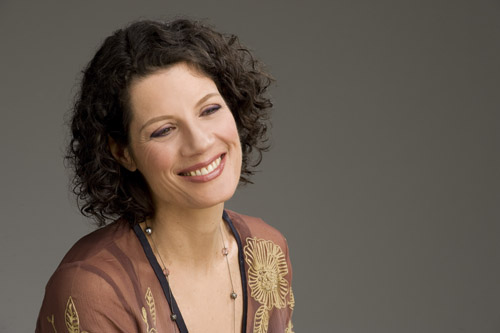
Devon wrote all the songs, played piano and guitar and did the vocals. At Bakerstreet Studios in North Vancouver “an amazing group of musicians” worked with her on other instruments including “guitar magician Robbie Steininger." Producer Rolf Henneman, who has produced albums for Heart, Roy Forbes and Raffi, has more than 30 gold and platinum awards to his name.
Nothing But Sky will be released on Sunday, December 14 at Bemused Bistro on Marine Avenue from 7 to 9 pm. The community is invited to the launch, to hear great music and enjoy complimentary appetizers.
Get the music: Nothing But Sky is available at Silke's Organic Food Market on Marine, The Flying Yellow Bread Bowl, Powell River Academy of Music, and Beyond the Bed, or email Devon at devonhanley@shaw.ca or call 604 483-3611 to order a copy.
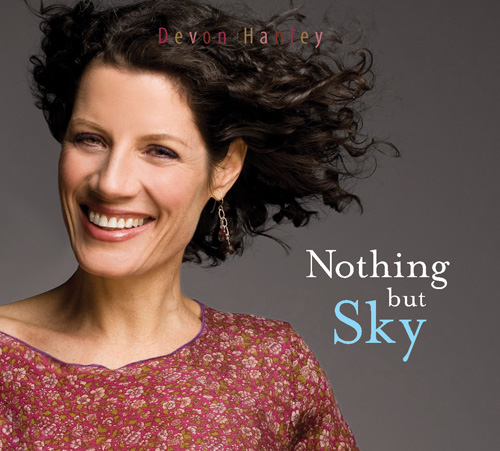
In today’s eco-conscious world, the term “Green Christmas” has changed in meaning. I can hear some people groaning...”A Green Christmas? Isn’t anything sacred? Christmas should be a time of generosity and giving!” Oftentimes people associate being eco-friendly with sacrifice—but it doesn’t have to be that way.
The holiday season is a special time to most of us, but the overconsumption that plagues this time of year can put a strain on finances, and a damper on the spirit of things. The key is differentiating between generosity and excess. When you are planning your Christmas, consider the impact and statement of gifts, decorations, and the events you are hosting.
Gifts
The way we spend our money can send a powerful message to the companies that produce the items we consume. Look at the products you are buying carefully—where were they made, and how? What are they made of? How long will they last? Does the person you are buying for need what you are buying? Choose to spend your money on ethically made, eco-friendly gifts and you will be supporting businesses trying to be more environmentally and socially responsible. You will also be raising awareness of important issues among your friends and family. Check out these websites for green gift ideas:
• wwfstore.donorportal.ca
• www.jalutoys.com (a Powell River manufacturer of wooden toys)
• www.grassrootsstore.com
Decorations
The Christmas tree is perhaps the most important and traditional decoration of the season. But plastic ones are bad for the planet, and cutting a real one down is a waste. Consider buying a living tree in a pot—you can plant it in your yard or somewhere in your community once it has served its decorative purpose—or designate a living, outdoor tree as your ornamental tree of choice. Alternatively, make it a family project to create a Christmas tree from recycled materials—your imagination is the only limit! Check out www.joytotheplanet.com for ideas.
Wrapping paper is another huge part of Christmas—and a huge part of the garbage that we throw away on Boxing Day. A lot of Christmas wrapping contains plastic or other materials that make it shiny and pretty, but unfortunately un-recyclable. The best kind of wrapping is the kind you can use many times. Wrap gifts in colourful cloth and ribbon for a beautiful waste-free package, or in maps, magazine pages or other colourful paper that can be recycled at the end of the day. According to the Sierra Club, if every family in Canada wrapped just three gifts this way, it would save enough paper to cover 45,000 football fields.
Events
Hosting get-togethers is one of the great pleasures of the Christmas season. It can also be a huge garbage-generator. Planning and hosting a party is a lot of work, and many people think, “it’s just easier” to get disposable plates, cutlery, napkins etc. But this is the best opportunity you will have all year to make a big difference in your garbage volume—and to make a statement doing it. Spend a bit of time collecting or making colourful cloth napkins and organize enough real plates, glasses and cutlery for your guests. The gesture will make your party earth friendly AND even classier.
By keeping this in mind and making the effort for a waste-free Christmas, you’ll be giving yourself, your family, and your loved ones the best gift of the season—a better, healthier planet on which to live.
Have a Merry Green Christmas!
Point of VIU
A celebration and a gift
By Dawn McLean
This fall, Malaspina University-College was named a “Special Purpose, Teaching University” by the provincial government and renamed Vancouver Island University (VIU). The announcement was good news for students and residents of this community. Ralph Nilson, VIU president, says, “This designation will increase access to university degree programs in central Vancouver Island and in Powell River without impacting the breadth of training currently available…VIU is one of only a few universities in Canada that offers such breadth of training available at our institution.”
As a new university, VIU will continue to focus on serving the diverse educational and training needs of the region. VIU will be able to respond to the changing social and economic agenda in Powell River. Career, trades, and upgrading programs will be emphasized.
Increasing opportunities for Aboriginal students is a goal of the new university. It is fitting, then, that the first chancellor appointed by VIU is Shawn Atleo, A-in-chut, a Hereditary Chief from the Ahousaht First Nation and the British Columbia Regional Chief of the Assembly of First Nations. A chancellor is the carefully chosen figurehead of a university. Shawn Atleo is seen as a role model and a leader dedicated to education.

In September, Chancellor Atleo was welcomed to the Powell River Campus by the students, staff, faculty and community. During the ceremony, he presented a yellow cedar paddle as gift to the campus and told the story of the paddle:
“I wanted a gift that signified a journey because I come from a canoeing and whaling culture. Paddles signified moving together, pulling together, working together in a canoe. When in big water, people are completely relying on others in a canoe. The paddle represents the journey in both a physical and spiritual sense: when the paddle is being stroked in the water, we can only see half of it. The spiritual side we cannot see. Being part of a team in the water is something that touches a person forever, just like the experience of attending school.
“The paddle was made by Brian Bob, Qwuyutsapulth, of the Coast Salish/Ucluelet , who now lives in Sna naw as (Nanoose). The gift of the paddle represents the journey people go on while following their educational goals. It is made of yellow cedar, and although it is very beautiful, it is functional. The salmon are included to signify the journey. They leave, but travel upstream to come home. That is why we educate our youth with the hope that they will bring back their learning to their communities. The copper points are the eggs of the salmon glinting with suggestion at the connection to the next generation.
“Although this paddle is beautiful artwork, it is given with the hope that it will be used. Dip it in the water the first day of a significant journey; dip it again on the last day. Use it as a talking stick or in ceremonies. Keep it where people can touch it, feel it, and hold it. It will start to turn, fade as part of its journey, and this honours the living culture.”
The paddle will be displayed at the Powell River Campus at VIU. Other campuses were given a similar gift, with the Nanaimo Campus receiving the steersman paddle.
Family Place celebrates families
Drop-in centre freely available
By Jean MacKenzie
The people you meet on a typical day at Family Place represent a diversity of cultures and traditions. Be it at Christmas, Hanukkah, Davali, or Yule, we all celebrate a renewal of hope for the future by gathering with families and friends as we celebrate abundance by eating traditional foods, and exchanging gifts that signify our care and attention for loved ones. An important part of every tradition is to create a time of magic and joy for the children who best represent those future hopes.
Family Place, a family drop-in centre in the Town Centre Mall, celebrates this commonality among families all year round. Now nearing its fifth birthday, the centre is freely available to all parents with young children. One of over 300 such programs in British Columbia, our Family Place has evolved into a kind of neighbourhood house or community centre. Parents at the beginning of their lives as parents and active members of the community brought together from all walks of life by their common need to feed a child or to allow a toddler to blow off steam in the midst of a busy day, meet here and make friends and take part in creating a support network that will sustain them in years to come.
Especially for the many families with young children who have chosen Powell River as the place to raise their families, the power of making a friend cannot be underestimated. In our surveys parents cite the positive role that Family Place has had on their decision to remain in our tightly knit community just because they were able to make one friend.
Families also come to Family Place to attend enhancement programs such as Parent-Child Mother Goose, Toddler Time, and Rhythm Circle Time, to borrow a book from the Book Bag Exchange, or to take part in the community action group, The Open Space for Parents or to enjoy the fellowship of creating the monthly Stone Soup. Many families look forward to the summer program and children’s activities.
Family Place can act as an entry point for parents to access support services.
Readers may have heard about Family Place's miniscule budget and struggle to remain open. Most programs for young children struggle with increasing expectations and exist from one crisis to another, which is surprising since services for young children are remarkably cost effective. Years after Canada signed the UN Declaration on the Rights of the Child, we are still failing to take advantage of the cost savings, around $17 for every dollar spent before the age of five, of providing the support that children need if they are to reach their potential to become healthy responsible members of our communities.
Family Place is open Tuesday through Thursday, 10:30 am to 4:30 pm and on Fridays from 12:30–4:30 pm. For more information call 604 485-2706.
Book benefits Therapeutic Riding
Story shows how horses help with healing
Local author K.L. (Kim) Denman has invited Powell River Therapeutic Riding to participate in the launch of her newest young adult novel, Spiral.
SPIRAL will be launched at the Powell River Library on Thursday December 11 from 6:30 – 7:30 pm; Kim will be reading from her novel and autographing copies of Spiral.
“Powell River Therapeutic Riding Association is grateful to Orca Books Publishers for donating all the proceeds from the sale of Spiral at this book launch to Powell River Therapeutic Riding Association,” said Lin Johnson, president of Powell River Therapeutic Riding. “The funds will be used to care for our five therapy horses, Beau, Apollo, Peppy, Desi and Fashion.”
Spiral is a novel suitable for young adults that tells the story of Abby, who is seriously injured at work when she is only 15. Her wounds go far deeper than her broken back, and refusing to participate in life, Abby withdraws into drugs and despair.
Abby is sent to a farm that offers equine assisted therapy and with the help of the horses, decides that she can learn to be present in her new life.
Kim has generously agreed to donate a classroom author visit or mini creative writing workshop to the school that sends the most people to the book launch.
In addition to Kim’s reading and the author visit contest, Powell River Therapeutic Riding members will be on hand and will bring a slide show presentation of the therapy horses and volunteers.
For more information contact Lin Johnson at Powell River Therapeutic Riding at 604 485-0117.
Spiral, by K.L. Denman
Reviewed by Hailey Sacree
I always love reading local authors’ work, and Spiral, written by KL Denman, is a really cool book.
Spiral is all about this 15-year-old girl named Abby who becomes paralyzed from the waist down after an accident where she breaks her back. In a wheel chair as a paraplegic for the rest of her life, having to learn how to live and do everything in a whole new way was very stressful. Knowing you may never walk again, never play another soccer or basketball game would be hard, really hard.
Abby distanced herself from all her friends, broke up with her boyfriend and fell into a kind of depression. She was sent to a place to learn with a group on how to maintain your health while in a wheel chair but that backfires when she becomes addicted to cocaine. After one sniff she is addicted and can’t stop. When her parents find out she is sent to rehab for six months. (I remember thinking "ouch!" that is kind of harsh). It is there that Abby turns her life around.
Denman’s writing shows you how beautiful a person’s recovery can be. The journey is difficult but it is rewarding in the end.
